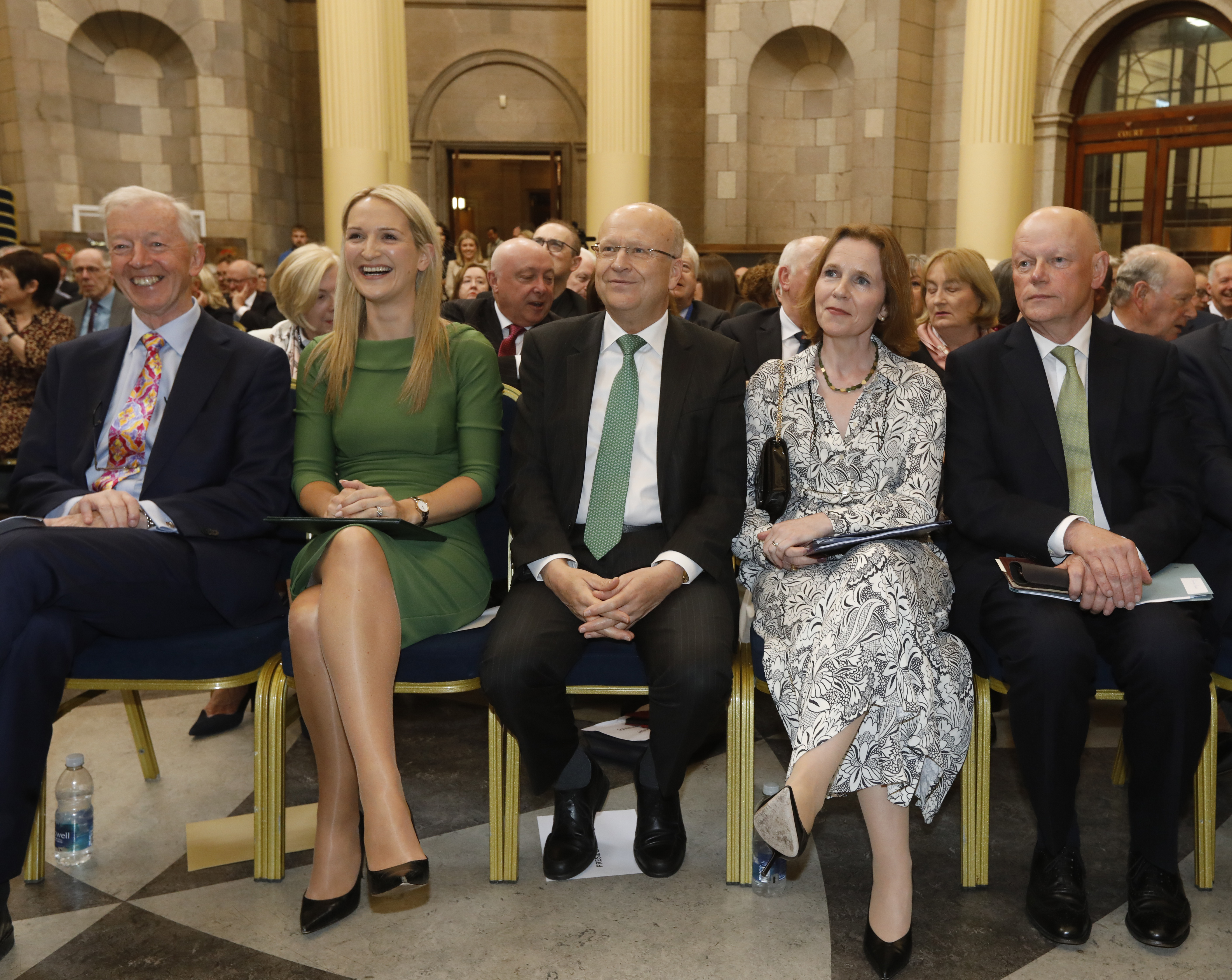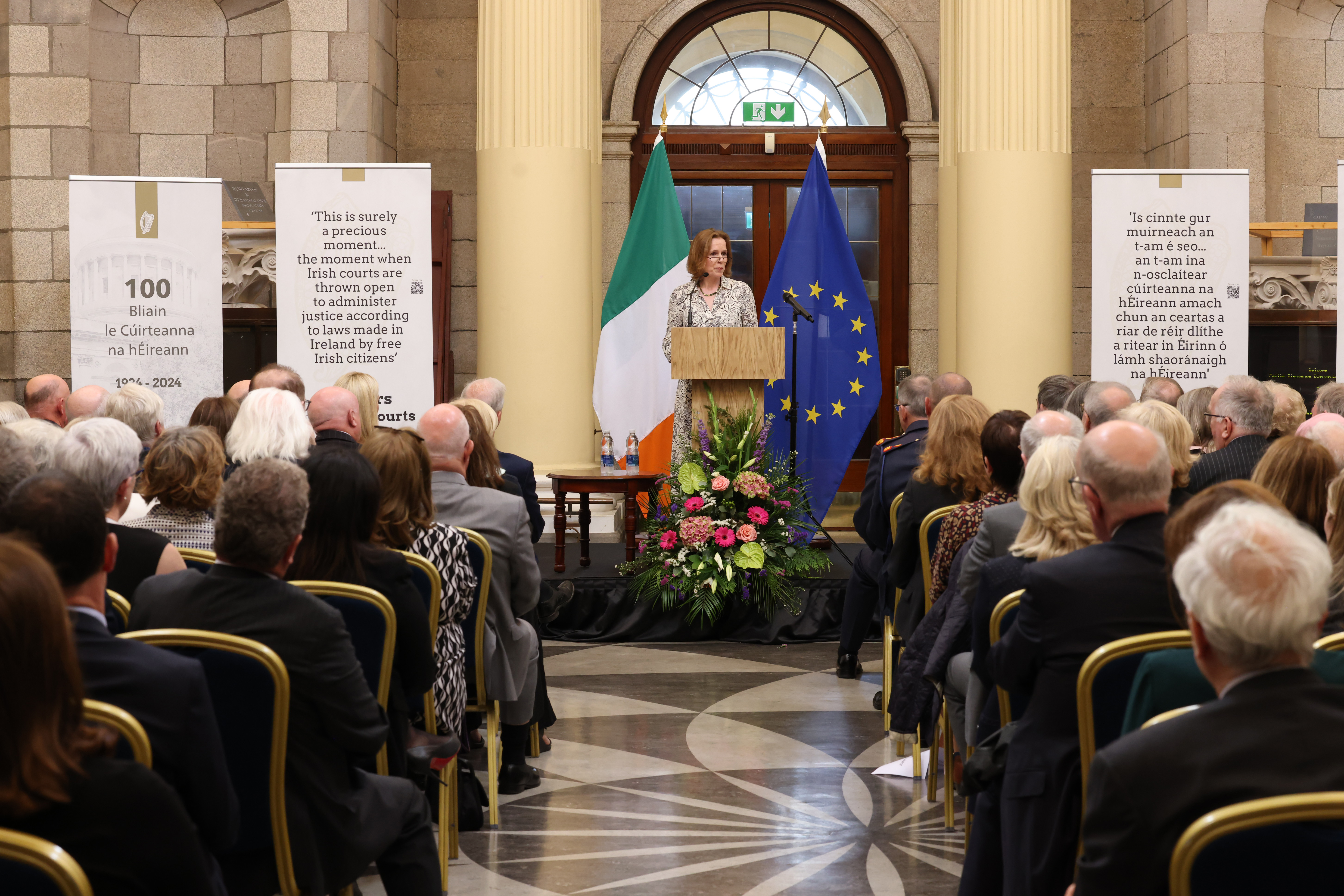Centenary of Independent Courts System

To mark the centenary of Ireland’s independent courts system, a committee of judges and Courts Service officials hosted a commemorative ceremony in the Round Hall of the Four Courts on 28 May. The ceremony was chaired by His Honour Judge Paul Kelly, President of the District Court, and speeches were given by Helen McEntee TD, Minister for Justice, Koen Lenaerts, President of the Court of Justice of the European Union, and Síofra O’Leary, President of the European Court of Human Rights.
Unwavering commitment
In her speech, Minister McEntee commended “the unwavering commitment” of the judiciary, past and present, the legal profession, government departments and other institutions of the State “to serving those who interact with our justice system." Addressing members of the international judiciary in attendance, the Minister noted that “[t]he august and international nature of this gathering [wa]s a measure of the respect in which the Irish judiciary is held across the world, with visitors from the United Kingdom, our European courts, and from as far away as India and Tanzania.”
The Minister described how the Courts of Justice Act 1924, “was instrumental in the establishment of our nation's distinct court system, comprising the District Court, Circuit Court, High Court, and Supreme Court.” With the addition of the new Court of Appeal in 2014, she observed that “these independent courts have for a century undertaken the administration of justice in our society”.
Referring to some important case law of the Irish courts, the Minister described how such jurisprudence “has significantly reshaped Irish society, our democracy, and our place in the world” and “have served to strengthen and uphold the public’s strong trust in Ireland’s independent judiciary”.
Minister McEntee reflected on the independence of the judiciary, being not just a characteristic of a democratic society, but “its foundation” which must be supported in a practical sense to ensure that justice can be administered impartially, free from external pressures and influences, and upholding the rule of law.
The Minister thanked all those who have served and worked in our courts, including the judiciary, barristers, solicitors, members of the Courts Service and the teams of people who work to ensure the smooth running of our courts up and down the country. The Minister's speech can be read in full here.
A shining example
Koen Lenaerts, President of the Court of Justice of the European Union, said that for half of a century, Irish courts, in cooperation with the Court of Justice, have played a vital role in guaranteeing that in the interpretation and application of the EU Treaties in Ireland, the law is observed. He observed that “Ireland’s common law tradition has positively influenced the Court of Justice’s case law. Building the law following a ‘stone-by-stone’ approach, distinguishing between lines of case law, and giving value to precedent are all features of the common law tradition that one may find in the case law of the Court of Justice.”
Discussing the Irish courts’ engagement in the preliminary reference procedure, the President said that the dialogue between Irish courts and the Court of Justice of the European Union is “a shining example of European integration moving forward through law and in keeping with the rule of law”. Click here to read President Lenaerts' speech in full.
An enduring relationship with the European Convention on Human Rights
Addressing the ceremony, Judge Síofra O’Leary, President of the European Court of Human Rights suggested that Ireland was “both an outlier and a pioneer when it came to the Convention”. On the one hand, Ireland’s experience of the Second World War, and its national ambitions and preoccupations in its aftermath, distinguished it from the other ten signatory States. On the other hand, Ireland’s pioneering status was reflected in its being one of the first Convention signatories, the first State to recognise the jurisdiction of the European Court of Human Rights, the second to accept the right to individual petition, the first State to see the Court’s jurisdiction exercised with reference to it as a respondent State in Lawless,[1] and the first State to introduce an inter-State case which culminated in a court judgment.
Reflecting on the Irish courts’ history of engagement with the European Court of Human Rights, President O’Leary said that any narrative “should not blind us to a relationship which has endured for over 70 years and to the concrete fruits of that engagement seen from the perspective of a now 100-year-old court system, as well as the Convention system of which it forms a part.” Click here to read President O'Leary's speech in full.
A spirit of radical evolution
In his remarks, Chief Justice O'Donnell referred to the striking and drastic changes that the Courts of Justice Act 1924 brought about. He suggested that if people involved in the courts system then could see it today, there would be much that they would recognise, but that they would be surprised and impressed by many of the changes that have occurred in the last century.
Referring to the commemorative event, the Chief Justice considered it “an opportunity to take stock and to reengage with the same spirit of radical evolution and indeed idealism that was present in 1924”.
The Chief Justice acknowledged the significant reforms which have improved the system, including the establishment of the Courts Service and investment in its modernisation programme, Judicial Council, The Judicial Planning Working Group, the establishment of the Courts of Appeal and reform of the Supreme Court.
All of these recent and proposed developments, he said, have been successful, and they should increase rather than satisfy our appetite for reform. Click here to read the Chief Justice's speech in full.
Decade of centenaries
The commemorative event was one of a number of projects being undertaken by a committee of judges and Courts Service staff. Other events and projects include a forthcoming podcast series, public tours of the Four Courts on the 15 June, publication of the second edition of ‘Supreme Court of Ireland: a history” and refurbishment works carried out by OPW.
[1] See Lawless v. Ireland (No.1), No. 332/57 (ECHR, 14 November 1960), Lawless v. Ireland (No.2), App No 332/57 (ECHR, 7 April 1961), and Lawless v. Ireland (No.3), No. 332/57 1 July 1961.

